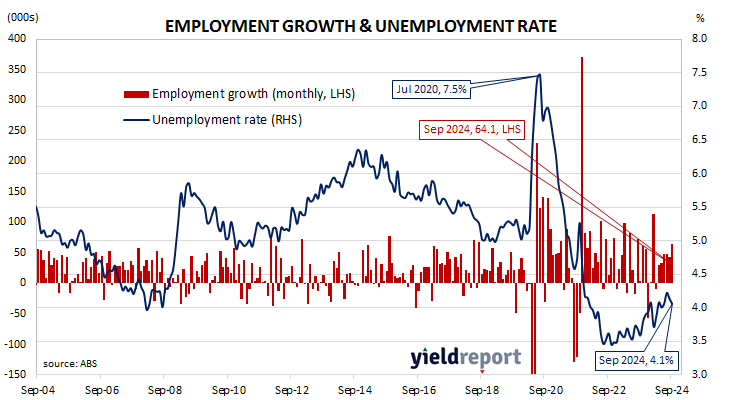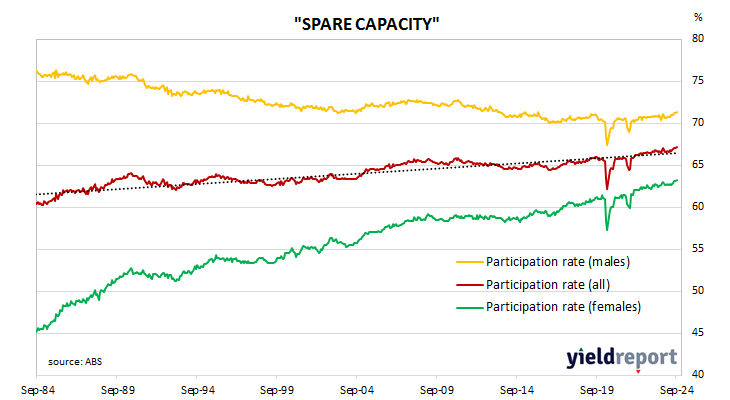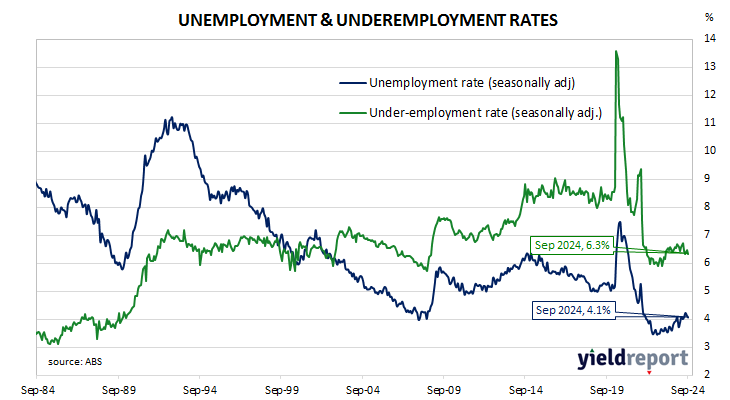Summary: Employment up 64,100 in September, more than expected; Westpac: employment growth stable at robust level; ACGB yields rise; rate-cut expectations soften, Feb cut less likely; ANZ: likely implies pick-up in GDP growth in September quarter; participation rate rises to 67.2%; jobless rate steady at 4.1%; more part-time jobs, full-time jobs; aggregate work hours up 0.3%; underemployment rate falls to 6.3%.
Australia’s period of falling unemployment came to an end in early 2019 when the jobless rate hit a low of 4.9%. It then averaged around 5.2% through to March 2020, bouncing around in a range from 5.1% to 5.3%. Leading indicators such as ANZ-Indeed’s Job Ads survey and NAB’s capacity utilisation estimate suggested the unemployment rate would rise in the June 2020 quarter and it did so, sharply. The jobless rate peaked in July 2020 but fell below 7% a month later and then trended lower through 2021 and 2022.
The latest Labour force figures have now been released and they indicate the number of people employed in Australia according to ABS definitions increased by 64,100 in September. The result was greater than the 22,300 rise which had been generally expected and up from August’s downwardly-revised increase of 42,600.
“After having slowed gradually over the past two years, employment growth looks to have stabilised at a robust level,” said Westpac economist Ryan Wells. “On a three-month average basis, employment is tracking 2.9% per year, a similar pace to what was seen at the turn of the year.”
Commonwealth Government bond yields rose moderately across a slightly flatter curve on the day. By the close of business, the 3-year ACGB yield had gained 6bps to 3.78% while 10-year and 20-year yields both finished 5bps higher at 4.26% and 4.65% respectively.
Expectations regarding rate cuts in the next twelve months softened, with a February 2025 rate cut now less likely. Cash futures contracts implied an average of 4.31% in November, 4.25% in December and 4.23% in February 2025. September 2025 contracts implied 3.67%, 67bps less than the current cash rate.
“The strength in employment does present a degree of tension with the ongoing soft pace of GDP growth,” noted ANZ Head of Australian Economics Adam Boyton. “While hours worked had been running softer than employment growth, hours worked is now recorded as being up 2.4% year on year. That implies either a pick-up in GDP growth in the September quarter or a continuation of Australia’s weak productivity performance. Based on what we know about Q3 so far, the latter appears more likely than the former.”
The participation rate hit a new series-high of 67.2% as the total available workforce increased by 54,900 to 15.137 million. The number of unemployed persons decreased by 9,200 to 615,700 but the unemployment rate remained steady at 4.1% after rounding and revisions.
The aggregate number of hours worked across the economy increased by 0.3% as 12,500 residents gained part-time positions and 51,600 residents gained full-time positions. On a 12-month basis and after revisions, aggregate hours worked increased by 2.4% as 182,300 more people held part-time positions and 252,600 more people held full-time positions than in September 2023.
More attention has been paid to the underemployment rate in recent years, which is the number of people in work but who wish to work more hours than they do currently. September’s underemployment rate declined from 6.5% to 6.3%, 0.4 percentage points above this cycle’s low.
The underutilisation rate, that is the sum of the underemployment rate and the unemployment rate, has a strong correlation with the annual growth rate of the ABS private sector wage index when advanced by two quarters. September’s underutilisation rate of 10.4% corresponds with an annual growth rate of about 4.0%.




